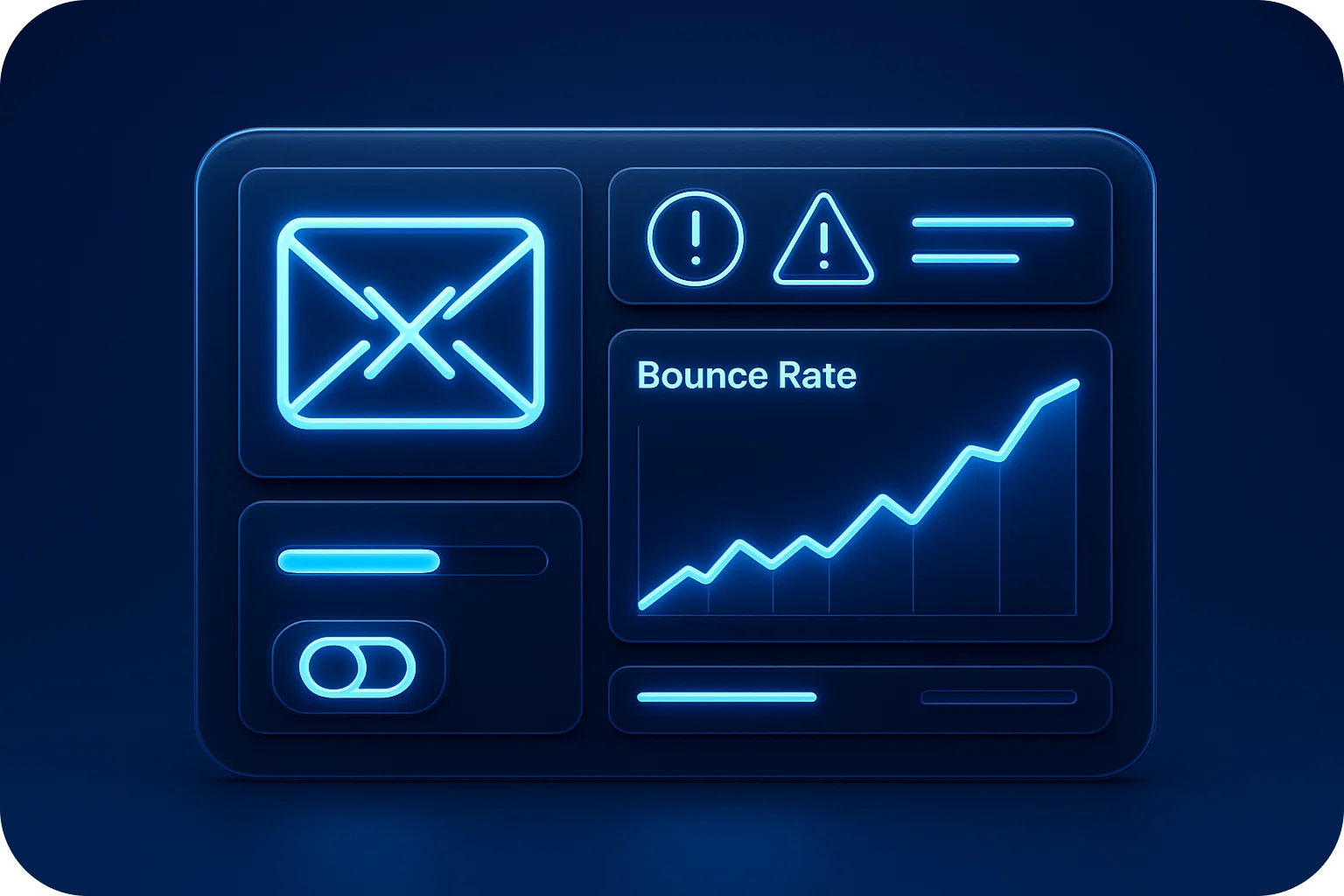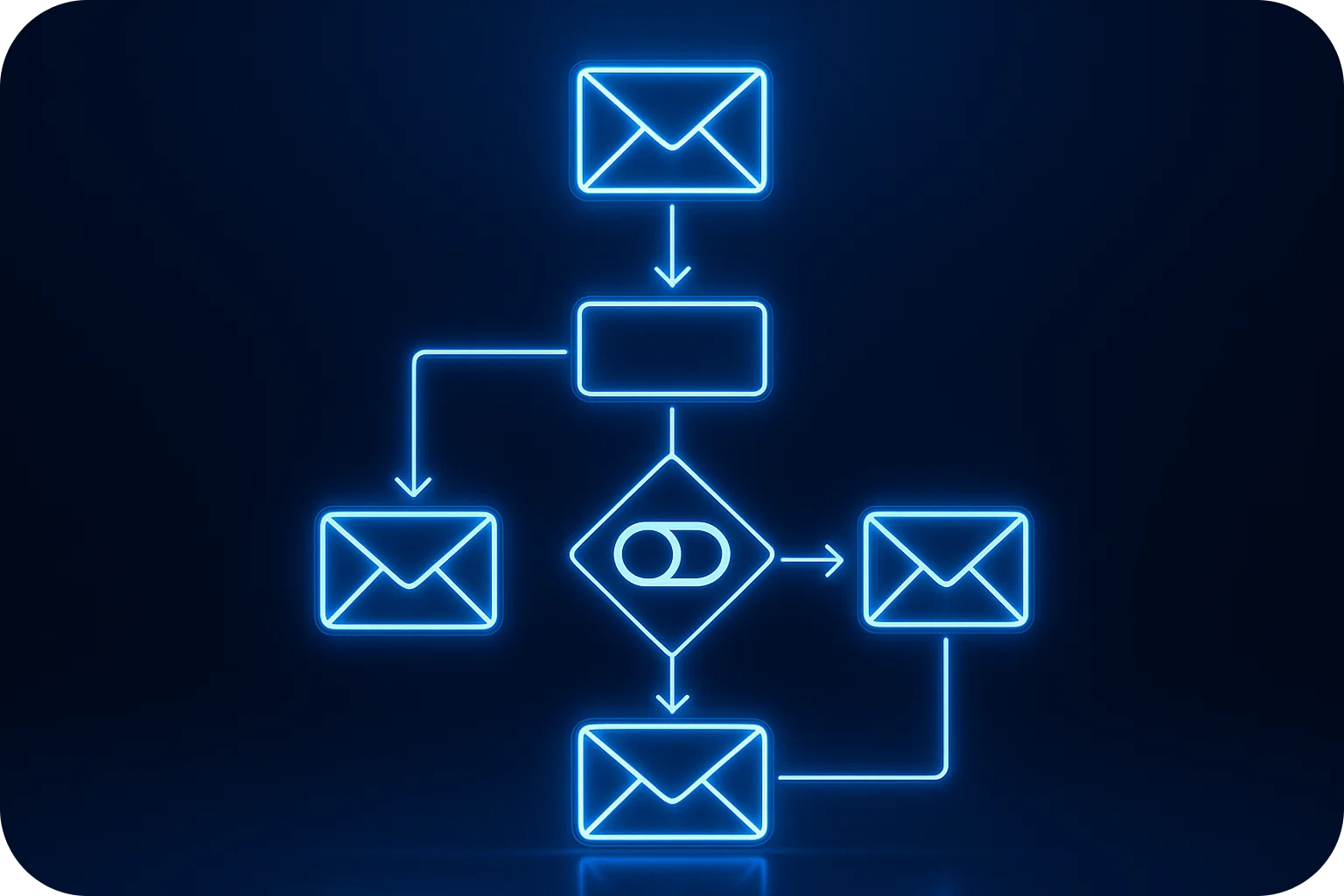The Email Bounce Recovery Playbook: Turning Hard Bounces Into Actionable Insights

Every cold email campaign tells a story through its metrics. While open rates and click-throughs often steal the spotlight, there's one metric that deserves far more attention than it typically receives: your bounce rate.
Hard bounces aren't just failed delivery attempts. They're diagnostic signals that reveal critical insights about list quality, data hygiene, and the long-term health of your email infrastructure. For sales teams, growth agencies, and anyone scaling cold outreach, understanding how to analyze and act on bounce data separates sustainable campaigns from those that gradually erode sender reputation.
Understanding the Anatomy of Email Bounces
Before diving into recovery strategies, it's essential to distinguish between bounce types and what they signal about your email operations.
Hard bounces occur when emails are permanently rejected. The recipient address doesn't exist, the domain is invalid, or the receiving server has blocked your sender completely. These are non-negotiable failures that require immediate attention.
Soft bounces are temporary delivery failures caused by full inboxes, server issues, or message size limits. While less critical than hard bounces, patterns in soft bounces can indicate deeper problems with your targeting or technical setup.
The distinction matters because your bounce rate calculation and response strategy should focus primarily on hard bounces. A hard bounce rate above 2-3% signals serious list quality issues that threaten your sender reputation across all major email providers.
Why Hard Bounces Are Your Early Warning System
When Gmail, Outlook, or any major email provider evaluates your sender reputation, bounce rates factor heavily into their algorithms. High bounce rates signal that you're sending to unverified lists, scraping contact data, or operating with poor data hygiene practices.
The consequences compound quickly. As your sender reputation deteriorates, more of your emails land in spam folders, even for valid recipients. Your domain gets flagged. Your IP address earns a poor reputation score. Eventually, you face the possibility of being blacklisted entirely.
But here's the opportunity most teams miss: hard bounces provide actionable intelligence about where your prospecting process breaks down. Each bounce category reveals a specific failure point you can address.
Categorizing Your Hard Bounces for Maximum Insight
Not all hard bounces are created equal. Breaking them down into categories transforms raw bounce data into a diagnostic tool.
Invalid email addresses represent the most common hard bounce type. These occur when the email format is correct but the address simply doesn't exist. High rates of invalid addresses suggest problems with your data sources, lead enrichment tools, or manual entry processes.
Invalid domains indicate you're attempting to send to companies that no longer exist or domains that were never valid. This often happens with outdated databases or when using automated tools that generate email addresses based on naming conventions without verification.
Blocked senders are the most serious category. These bounces mean the receiving server has specifically rejected your domain or IP address. This signals reputation damage that requires immediate intervention.
Policy-related rejections occur when your emails violate the receiving server's policies around content, authentication, or sending patterns. These bounces often indicate technical configuration issues with SPF, DKIM, or DMARC records.
By tracking which categories dominate your bounce reports, you pinpoint exactly where to focus your recovery efforts.
The Bounce Analysis Framework
Transforming bounce data into actionable insights requires a systematic approach to analysis.
Start by establishing your baseline bounce rate across all campaigns. Calculate this by dividing total hard bounces by total emails sent, then multiplying by 100. Track this metric weekly to identify trends before they become crises.
Next, segment your bounce rate by data source. If you're pulling contacts from multiple lead databases, enrichment tools, or manual research, calculate separate bounce rates for each source. This reveals which vendors or methods consistently deliver poor data quality.
Analyze bounce rates by domain type. Are you seeing higher bounces with certain email providers or company sizes? Bounces concentrated among small businesses might indicate those companies have higher turnover or less stable email infrastructure. Patterns among specific industries could reveal data quality issues with those verticals.
Review the timing of bounces within your campaign sequence. Do bounces spike on the first email or later in the sequence? Early bounces suggest fundamental data quality problems. Later bounces might indicate that recipients are actively blocking you after initial contact.
Immediate Actions When Bounce Rates Spike
When your bounce rate suddenly increases, swift action protects your sender reputation and preserves deliverability for valid contacts.
Pause affected campaigns immediately. Continuing to send while bounce rates are elevated accelerates reputation damage. Stop all campaigns using the affected list or data source until you've diagnosed the problem.
Quarantine bounced addresses. Create a suppression list of all hard bounce addresses and ensure they're excluded from all future campaigns. Never attempt to resend to hard bounce addresses, as this signals poor list management to email providers.
Audit your data source. If bounces spiked after adding a new lead list or changing data providers, that's your culprit. Verify a sample of addresses from that source manually before using any additional data.
Check your email authentication. Sudden bounce increases sometimes indicate technical issues rather than list problems. Verify that your SPF, DKIM, and DMARC records are properly configured and that recent DNS changes haven't broken authentication.
Review recent content changes. If bounces coincide with new email copy or templates, policy-based rejections might be triggering blocks. Test your content against spam filters and remove any elements that might trigger automated rejections.
Building a Proactive Bounce Prevention System
The most effective bounce recovery strategy is preventing bounces before they happen. Implementing systematic verification processes protects both your sender reputation and campaign efficiency.
Verify email addresses before adding them to campaigns. Email verification services check whether addresses exist and can receive mail without actually sending a message. This catches invalid addresses before they impact your bounce rate or cold email metrics.
Implement double opt-in for any owned lists. While cold outreach doesn't use opt-in, any marketing lists you build should require confirmation. This ensures addresses are valid and actively monitored.
Regularly clean your database. Email addresses decay at approximately 22% annually as people change jobs, companies close, or domains expire. Quarterly list cleaning removes outdated contacts before they become bounces.
Monitor engagement signals. Addresses that never open emails over extended periods often become invalid eventually. Proactively removing chronically unengaged contacts prevents future bounces and improves overall metrics.
Diversify your data sources. Relying on a single lead database or enrichment tool concentrates risk. Using multiple verified sources with different strengths reduces the impact of any single source's data quality issues.
Leveraging Bounce Data to Improve Targeting
Beyond protecting sender reputation, bounce analysis reveals opportunities to refine your ideal customer profile and targeting criteria.
High bounce rates among certain company sizes might indicate your prospecting tools struggle with those segments. If small business contacts bounce frequently, those companies may lack the stable email infrastructure your targeting assumes.
Industry-specific bounce patterns reveal data availability challenges. Highly regulated industries or those with high turnover may require different prospecting approaches or more frequent data verification.
Geographic bounce variations highlight regional differences in data quality and email infrastructure. Markets with less mature digital infrastructure may require alternative outreach channels or more intensive verification.
Job title bounce patterns expose assumptions about email naming conventions. If emails to C-level executives bounce more frequently, your email construction logic may not account for how larger organizations structure executive email addresses.
Recovery Timeline and Reputation Repair
If bounce rate issues have already damaged your sender reputation, recovery requires patience and systematic reputation rebuilding.
Expect 4-6 weeks of careful sending to repair moderate reputation damage. During this period, send only to highly verified lists with strong engagement history. Volume should increase gradually, demonstrating improved practices to email providers.
Monitor your placement rates across major providers. Tools that test inbox placement help you track recovery progress and identify which providers still view your domain skeptically.
Consider using a fresh subdomain for new campaigns while your primary domain recovers. This isolates reputation damage and allows you to maintain outreach volume without further compromising your main domain.
For severely damaged reputations, a complete infrastructure reset may be necessary. This means new domains, new IP addresses, and starting from scratch with verified lists and conservative sending volumes.
Turning Insights Into Systematic Improvement
The ultimate goal isn't just recovering from bounces but building systems that prevent them while extracting maximum intelligence from the bounces that do occur.
Create a bounce review ritual. Weekly analysis of bounce patterns, categories, and trends should be as routine as reviewing response rates. This transforms bounce data from a lagging indicator into an early warning system.
Document what you learn. When you identify a data source with poor quality or discover that certain prospect segments produce higher bounces, record these insights. Over time, this institutional knowledge dramatically improves targeting efficiency.
Share bounce intelligence across teams. If your SDRs are manually researching contacts, feedback about which companies or industries produce more bounces helps them prioritize their time effectively.
Treat your bounce rate as a key performance indicator with the same weight as response rates or meeting bookings. Teams that monitor bounce rates as carefully as conversion metrics build more sustainable, scalable outreach operations.
Conclusion
Hard bounces aren't failures to hide or metrics to manipulate. They're valuable signals that reveal exactly where your prospecting process needs improvement. By analyzing bounce patterns systematically, implementing verification processes, and treating bounce data as strategic intelligence, you transform a potential liability into a competitive advantage.
The teams that scale cold outreach successfully aren't those that ignore bounces or accept them as inevitable. They're the ones that build systematic approaches to bounce analysis, prevention, and continuous improvement. Your bounce rate tells a story about your data quality, targeting precision, and operational maturity. The question is whether you're listening.
More articles
Get started now




%201.png)





